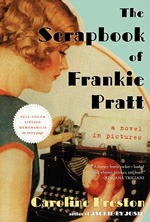

Ecco, hardcover, 9780061966903
The Scrapbook of Frankie Pratt reads like a fairy-tale journey of a young woman who wants to be a writer and embark on a life of adventure. Frankie's travels span a dramatic decade of history, beginning in 1920 when she receives the scrapbook as a high school graduation present from her mother.
Frankie wins a scholarship to Vassar College but, coming from a poor background, she doesn't take it; instead she decides to help her mother financially by becoming a nurse to an elderly woman. The situation soon gets messy when the woman's married son makes advances to the young nurse, which results in the elderly woman writing a cheque so Frankie can attend Vassar after all.
After graduation from Vassar, Frankie heads to New York to work on a magazine. Here she falls in love with a guy who has a shocking secret that breaks her heart. This experience propels her to travel by boat to Paris, where she gets a job working on a journal that publishes legendary literary figures such as Hemingway and Joyce, and she also has an interesting interaction with Edna St Vincent Millay. One of her literary friends even goes on to found the New Yorker magazine. And Frankie also witnesses Charles Lindbergh's dramatic landing at the end of his historic first flight across the Atlantic. There is romance for Frankie in Paris but, alas, not the committing kind.
Her adventures come to an end when she receives a letter from her mother who is ill, and Frankie knows she must return home. Although her story ends surprisingly conservatively, she still manages to come out a hero of her time.
Frankie is a highly likeable character with a keen sense of humour, and you want the best for her as she experiences pain and disappointment throughout the Roaring Twenties. Yet these negative experiences do not destroy her; she rises above them, always remaining true to herself and her quest. Although she seems to settle at the end of the story, Frankie does break away from the conventional expectations for a young woman at that time and we can only hope that she continues to forge a different path.
The physical book is a visual delight; it is set out in scrapbook form, and is chock full of vintage memorabilia. Each page is a work of art, and, to add to the vintage appearance, Frankie has typed the text of her scrapbook on an old Corona typewriter that had belonged to her father. The paper is heavy and smooth, and the colours are brilliantly reproduced. The art, styles, fashions and mores of the 1920s come alive in this stunning book. While it could be described as a graphic novel, its charm is in the artwork and use of memorabilia that draw you in to Frankie's adventures. This book would be a beautiful gift for a scrapbook enthusiast, book collector, or for anyone interested in the social history of literary young women in the 1920s.
